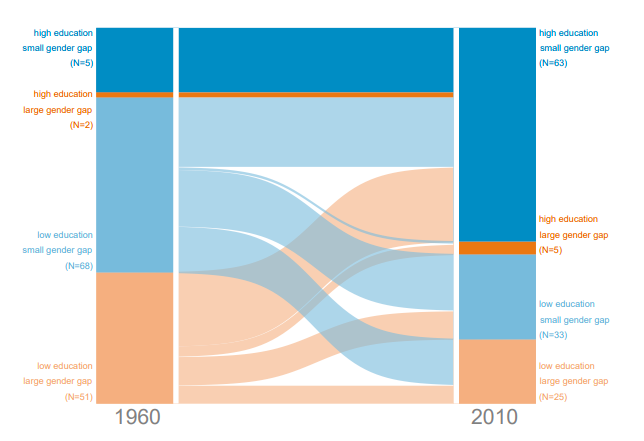Happy 2020! To kick off the year, we’re excited to share a recent episode of the Do One Better Podcast, in which host Alberto Lidji interviews Echidna Giving founders Craig Silverstein and Mary Obelnicki. Listen to the impetus behind founding Echidna Giving — including Craig’s theory of change, which, broadly characterized, “starts with girls’ education and ends with world peace” — how they got this work off the ground, and their recommendations for other philanthropists.
As we enter 2020, we have enjoyed reading reflections on trends of the past and forecasts for the future. Below are some of our favorites.
Looking backwards, we recommend a piece from David Evans, Maryam Akmal, and Pamela Jakiela at the Center for Global Development on Gender Gaps in Education: The Long View. In this piece, they find that: (1) “women are more educated today than 50 years ago in every country in the world,” but (2) “they remain less educated than men in the vast majority of countries.” They also find that (3) in many countries that started with low levels of education, gender gaps got worse before they got better (as enrollment expanded for boys first and then girls). Finally, they show that (4) “gender gaps rarely persist in countries where boys are attaining high levels of education.”
Our favorite graphic from the report is below, but read this twitter thread or the full piece for more.
 The third finding — that gaps may get worse before they get better — may soon be at play in preschool. For instance, recent research by Young Lives shows that Ethiopia has made major strides in expanding their “O-class” (a year of schooling before primary school starts), but “more boys than girls are going to O-Class.”
The third finding — that gaps may get worse before they get better — may soon be at play in preschool. For instance, recent research by Young Lives shows that Ethiopia has made major strides in expanding their “O-class” (a year of schooling before primary school starts), but “more boys than girls are going to O-Class.”
India’s latest Annual Status of Education Report looked specifically at learning outcomes for young children aged 4-8. Among the findings — nicely summarized in detail here and in this article — they show that girls are more likely to be enrolled in government preschools and parents are more likely to invest to enroll boys in private preschools.
As preschooling expands, can we expect to see gender gaps widen before they get better?
Another thoughtful look back from the Center for Global Development is Review of the Decade: Ten Trends in Global Education. Read in detail about the rise of universal secondary school, stagnation on universal primary school, the growth of private schools, the (unfulfilled) promise of ed tech, discovering the learning crisis, amping up RCTs in education, and more.
Looking forwards, Foresight Africa reflects on the top priorities for the continent in the coming decade. Among the 6 themes examined, the piece looks at leveraging demographic trends for economic transformation through job creation, skills development, and urbanization policies. There’s also a piece on closing the gender gap in African labor markets is good economics, which emphasizes that the lack of affordable care for children and the elderly decrease female labor force participation rates in developing countries by 4.8 percentage points. It emphasizes the gains countries could make by adding women to the labor market: “the gain in GDP ranges from 1 percent in Senegal to 50 percent in Niger.”
Likewise, a recent McKinsey piece looks at a set of priorities that will help in advancing women’s equality in Africa, including investing in human capital (education and skills training), creating economic opportunities, leveraging technology, shaping attitudes, and enforcing laws. This report also emphasizes the burden of unpaid care work that holds women back (the same is true in the U.S.). In fact, this is the dimension of gender equality at work against which Africa has made the least progress.
Given the above, what’s to be done in the here and now? A piece in Devex late last year describes how increasing the availability of high quality, affordable childcare could also be a big win for children’s outcomes. Is there room in the next decade to bring women and children advocates together to advance this agenda?
What other trends are you hopeful will come to fruition in the next decade? We’d love to hear from you in the comments section below!
